Hara stayed in contact with the developers at Capcom and when they asked the artist if he could help design the wrestlers for the Muscle Bomber / Saturday Night Slam Masters series he was happy to oblige. His intimate knowledge with wrestlers from the world over allowed him to put a unique spin on many figures. For example, the only female playable female character in the Muscle Bomber series was Black Widow. Her look and gimmick was modeled after Mariko Yoshida.
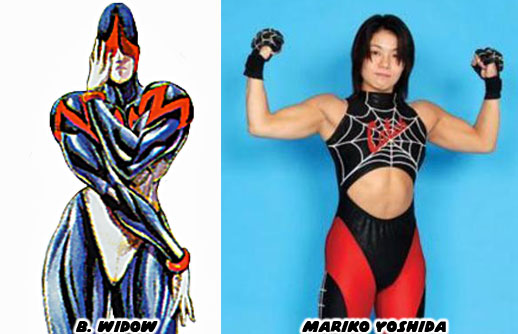
Hara was also the designer for adapting Big Van Vader into the Muscle Bomber series as Sheep the Royal aka Alexander the Grater. There were many masked wrestlers featured in his title, many from around the world. Hara helped demonstrate that great characters in fighting games came in all shapes and sizes. They did not all have to look like karate or kung-fu masters in order to be memorable. Best of all by extension the characters he created became part of the Street Fighter universe.
Game designers had an incredible diversity of designs for over 25 years. In early arcade and console games there could always be a masked wrestler to help break up the traditional karate and kung-fu characters that were all the rage. Many times the designers would push the idea of what a luchador could be and what fantastic moves they could contribute to the fighting game genre. Like the other characters in the title the moves that the wrestlers were given were great exaggerations of the actual fighting arts. A suplex was a dangerous throw but imagine how much greater it would look if the performer would leap and spin in the air with their opponent as they performed it. The same thought process was applied to pile drivers, power bombs and all sorts of real wrestling moves. They were made fantastic for the sake of the game. The luchadors and enmascarados that appeared in fighting games were sometimes mild adaptations, as with El Blaze or they were completely over-the-top as with King in Tekken or Tizoc in Garou Mark of the Wolves.
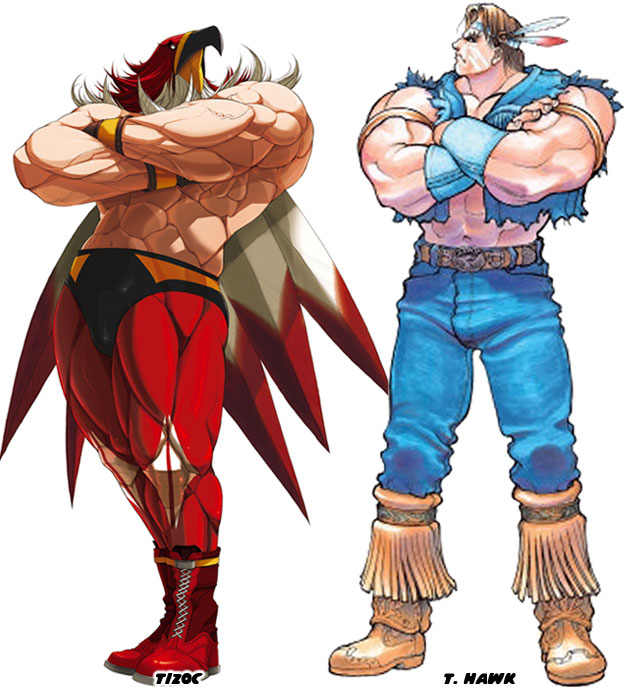
Pro Wrestling did not need masked wrestlers in order to create mysterious personas. Some of the most most popular characters often came "From Parts Unknown." It could be seen as lazy writing from bookers or inspired creativity by the performers themselves. By leaving the country of origin unknown the audience was allowed to imagine what far off island, or lost civilization these fighters came from. In many instances having a strange physical appearance was enough to keep the illusion alive. Some wrestlers were tall, gangly, obese, muscular or outright grotesque. George "The Animal" Steele was a heavy set and hairy man that would paint his tongue green. This plus his erratic mannerisms was enough to scare audiences into thinking that he was some sort of Neanderthal in wrestling trunks. Maurice Tillet aka the French Angel was an even earlier version of the monster man. Maurice suffered from Acromegaly which caused his hands and head to expand through most of his life. His features were proportioned for somebody much larger, making him look gruesome even against other less-than-handsome wrestlers. Some wrestlers used a little face paint or body paint in order to enhance their appearance. Dewey Roberts was a mid-card wrestler until he discovered his gimmick, a crazy haircut and some face paint, then he was elevated to stardom. He was known as the Missing Link and would brutalize his opponents by using headbutts over and over. The large Southerner James Harris was nicknamed the Ugandan Headhunter Kamala. Sometimes teamed with the Missing Link and formed Devistation Inc.
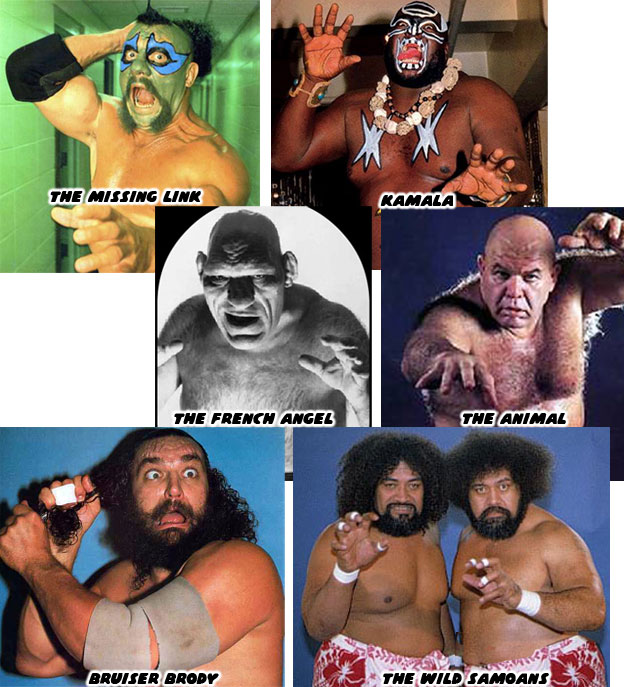
The origins of these gimmicks went back to the earliest days of wrestling in North America. Back when many performers worked the Sideshow in the circus. Sometimes the wrestlers were legitimate fighters and sometimes these fighters needed a gimmick to get them over with audiences. Sadly some of these gimmicks could actually be linked to racial biases and ignorance on foreign cultures. Previously on the blog I had mentioned how ignorance about the Indian fighting forms led to Chinese filmmakers exploiting Yoga as a fighting art. This in turn influenced the creation of characters like Dhalsim and the Great Tiger. Through the history of wrestling the islanders from the South Pacific were often presented as savages and wild men. In the early days of televised wrestling audiences in smaller markets genuinely believed that these men, and sometimes women, with large heads of hair were indeed Headhunters.
A savvy promoter might help develop a gimmick and convince audiences that their new talent was indeed from some sort of far off land. The wrestlers sometimes did not have to speak to the camera, and the gimmick worked better when they didn't, so that they could be presented as uncultured savages. The designers working on Street Fighter II had used wrestlers as a point of reference for several characters. One of those that ended up on the cutting room floor was an amalgamation of several "wild" wrestlers. The Uganda Warrior had a physical build similar to Afa and Sika, the Wild Samoans, as well as Jimmy "Superfly" Snooka but with the body paint of Kamala.
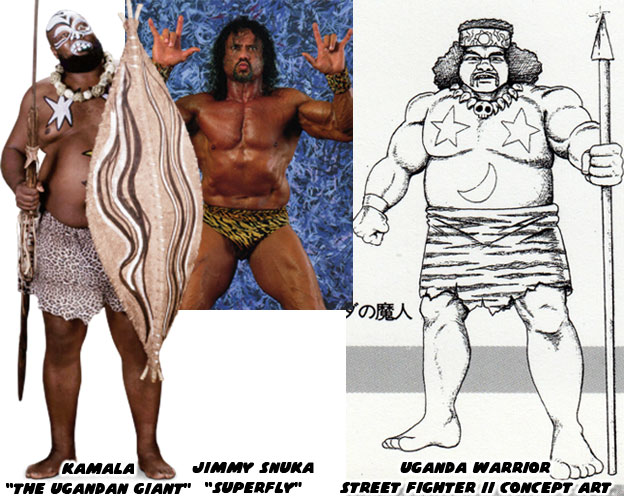
The savage wrestlers had a big presence in the ring. When promotions went from local television to the mainstream bookers knew to hire wrestlers that looked great on television. Those that had bodybuilder physiques and handsome faces were easier to book than the chubby ones that had actual fighting ability. Masked wrestlers were always great mystery opponents that would boost the ratings. Something that also worked great on television were the gimmick wrestlers that worked the wild man angle. These characterizations translated very well to fighting games. These savage figures were less like traditional wrestlers and more like animals when they fought. They sometimes scratched and bit opponents when the ref wasn't watching, they often celebrated when they were able to draw blood. The line between man and monster would be blurred depending on the performer, or in the case of gaming, depending on the designer.
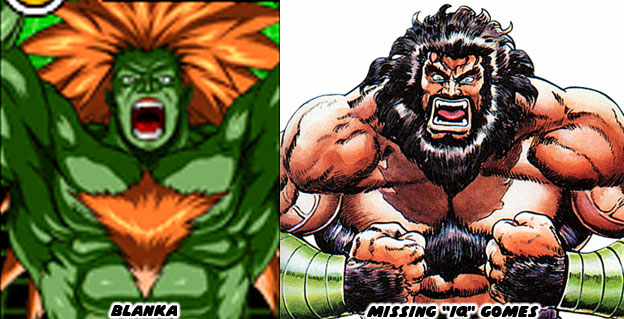
Take the character Blanka from the Street Fighter series and Missing IQ Gomes from the Muscle Bomber series. Both were featured in a Capcom title and both fell within the canon of Street Fighter. The figures were both extremely muscular, very hairy and had features that were almost ape-like.The major difference between the two was skin deep. Blanka was colored green with bright orange hair whereas Gomes had a more natural skin color. The senior designers working on Street Fighter II wanted to see how far they could push the wild man concept and still keep the attention of gamers. Blanka was rooted mainly on an earlier character called The Amazon that was featured in Nintendo's Pro Wrestling game. Artist Akira "Akiman" Yasuda wanted to make players feel powerless as Blanka would bite the face of his opponents as the Amazon did to him on the old Nintendo console.
Capcom could go way out with the look and Blanka would still work within the context of the series. Blanka had long extended ears, sharp teeth, claws (which were simply long nails) and shackles as if he were an escaped animal. He was a good counter-point to the character Dhalsim. Both featured very odd fighting styles and represented mysterious origins. They added a sense of wonder and fantasy to an otherwise traditional cast of boxers, kung-fu and karate experts.
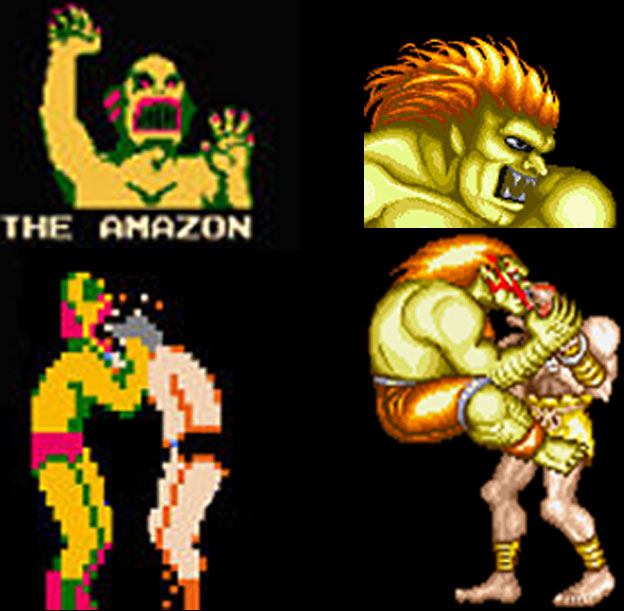
By comparison Gomes had many of the same features yet could have existed in an actual promotion. Like George Steele he was a very strong hairy man that acted irrationally in the ring. The wild outbursts performed by Gomes was something that a wrestler like Frank "Bruiser Brody" Goodish excelled at in real life. Tetsuo Hara tried to keep the majority grounded in reality. He had such tremendous respect for the art of pro wrestling that he didn't want to push the envelope as far as the Street Fighter II team had done. The gimmicks Hara exploited were strong for most of the wrestlers and even the more "exotic" characters could have existed in some promotion. The roots of Blanka's design were not as harmless as those used by Hara.
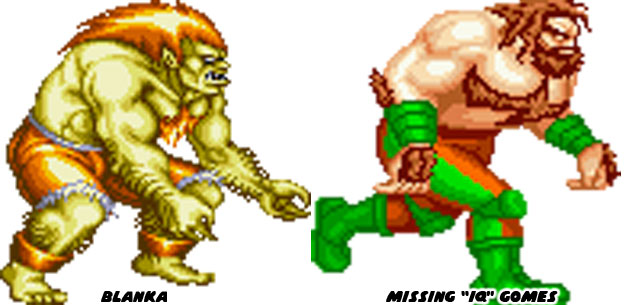
In the earliest concept art Blanka was a savage black man that was in chains. Tight curly hair, big lips and distorted proportions made him appear more ape than man. Somebody at Capcom had enough sense to change the design. The character known as Anabebe could have been a potential disaster, especially in the black community. Arcade games depend on making their audiences happy and keeping them happy. Street Fighter II would have offended many players overseas if figures like "Great Tiger" and Anabebe had not been rethought.
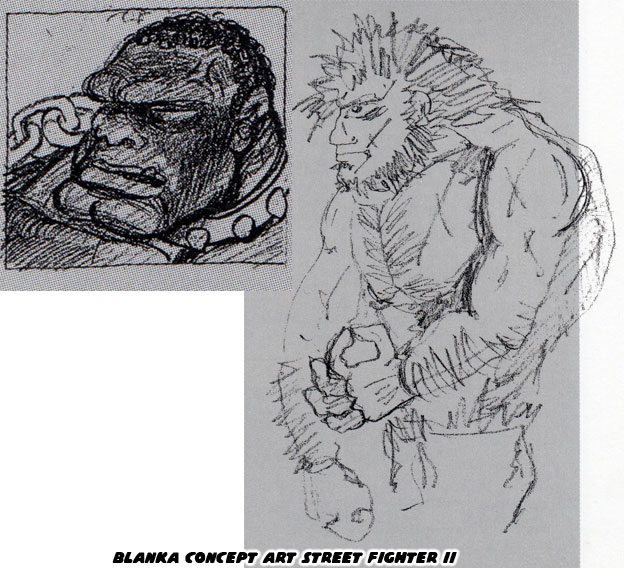
There was still an unmistakable draw to the wild man as a fighter. Many great characters in literary and movie history were based on the idea of a man becoming more like a monster. Think about the classic characters Dr. Jeckyl and Mr. Hyde, Frankenstein's monster, the Mummy, Dracula, and the Wolf Man. They were the inspirations for some of the longest-running movie characters. Universal Studios would revisit those characters time and time again. Modern retellings of these characters could be seen through comic book icons like The Incredible Hulk, Bane and Gorilla Grodd. The influence of these monsters with human traits was universally appealing. A version of the monster-as-a-man was in every culture and storytelling tradition. Capcom had even experimented with the genre by putting the iconic movie monsters in a fighting game known as Vampire / Darkstalkers. Yet for the Street Fighter franchise they wondered how far they could push the wild man, or savage man concept without losing the audience. Blanka had done very well for the series but the developers were looking to recast the game in Street Fighter III. The stretchy-limbed lab experiment named Necro was a variation of Dhalsim. The Chinese twins Yun and Yang were younger takes on Ken and Ryu.
The Blanka-type character for the game never made it past the planning stages. Ofuransu was described as being "a noble field beast." He was an aristocrat that had the features of a wolf man. This combination of royalty and hulking brute was very unique. It was not the only time that Street Fighter designers had kicked around the idea. Half of the team that worked on Street Fighter II left Capcom to form ARIKA. They created a game called Fighting Layer. It incorporated many ideas from Street Fighter II, including ideas left on the cutting room floor. The main villain of the game was an aristocrat named Vold Ignitio. He was more vampire than werewolf in the game, his regal costume beguiled his savage attacks. He would slash at opponents with his long fingernails and even pounce on opponents and bite at their necks.
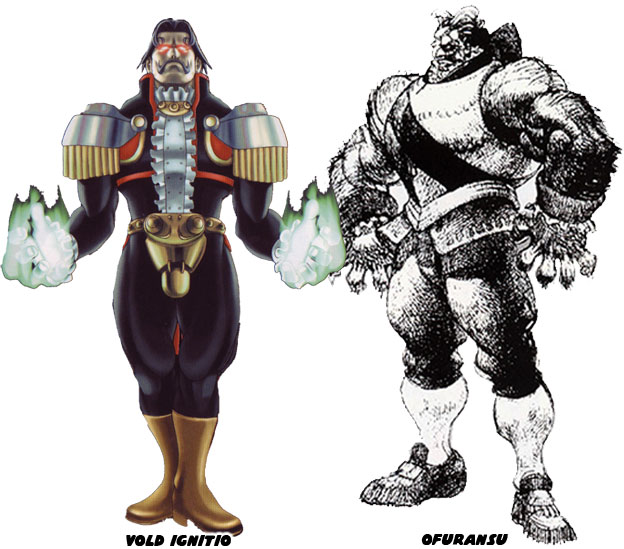
Wild men, monsters, savages and demons were on the extreme edge of designs that worked for the fighting game genre. The team working on Street Fighter III had even kicked around the idea of having a man made of stone, instead of the MMA fighter Alex, or the giant Hugo be the "strong" character in the title. The Golem was actually based on a character featured in what was considered the earliest horror film ever made, an experimental German film from 1915 titled Der Golem. The Golem was a man made of clay from Jewish myth. A person seeking revenge against a great adversary could bring the monster to life by using magic. He would write the name of the person he wanted to kill on a piece of paper and feed it to the Golem. The Golem would then go out and hunt his victim, never tiring, impervious to harm and never stopping until his mission was accomplished. This character was considered the basis for Frankenstein's monster. The character was obscure compared to the more famous movie monsters. That didn't stop the designers at Capcom from putting him on the table or even from the writers on the Simpsons from using him in a Halloween special.
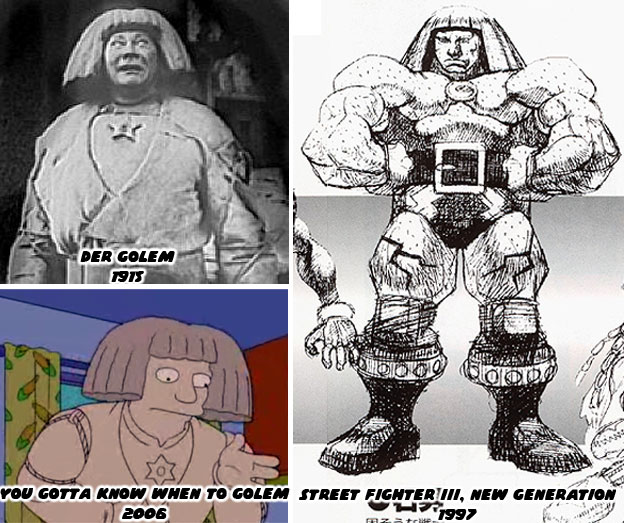
The designers at Capcom came to their senses and scaled back their character choices. They found a good balance between new fighting forms and returning characters as the Street Fighter III series took off. Wrestlers would remain popular choices while casting other fighting games. Artists like Tetsuo Hara would find success in adapting real wrestlers into the Muscle Bomber games. The champion of the universe was a semi-retired fighter by the name of Victor Ortega. The character was modeled after "Superstar" Billy Graham, one of the most colorful wrestlers from the '70s and '80s. Graham was a great in-ring worker and had an amazing bodybuilder physique. His look and gimmick would be copied for generations by Jessie "the Body" Ventura, Hulk Hogan and Scott Steiner. Ortega was one of the most muscular characters ever featured in a Capcom fighting game, easily beating the massive frames of Zangief and Darun Mister.
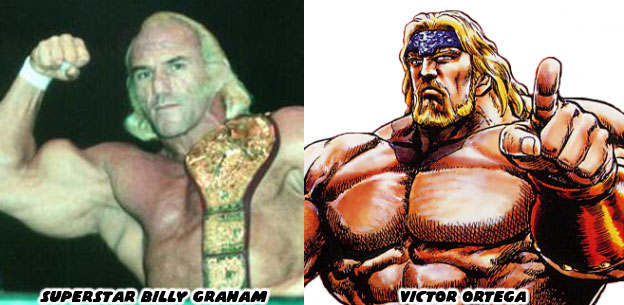
Despite its long and colorful history pro wrestlers, masked or not, were thought of as the bottom tier of the fight circuit. Television and motion pictures had convinced audiences that the best fighters stood on their feet and traded punches and kicks with each other until one person fell. Wrestlers did not really throw punches and kicks therefor they were not "real" fighters. The reality of combat was completely different. Most street fights and even professional fights ended up on the ground. It would be anticlimactic in most fighting games to have the final boss simply tackle the player and break their arm, even if that was what would work best in the real world. It was rare when a fight stayed upright but allegedly not for the best fighters. People like Bruce Lee and Mas Oyama were said to have ended fights quickly, before they could be taken down. When Oyama would have an open challenge sparring match he would often dispatch opponents with a single punch, usually to the torso instead of the head. Even with that said both men knew the importance of being well rounded fighters. They studied the grappling arts and knew how to stay on their feet even when people were desperate to take them down. Judo, jujitsu and wrestling were forms that they had learned a tremendous amount from. This made them much more formidable than any one style could have ever taught them. Achieving that level of expertise was not easy for the fighters.

The origins of these gimmicks went back to the earliest days of wrestling in North America. Back when many performers worked the Sideshow in the circus. Sometimes the wrestlers were legitimate fighters and sometimes these fighters needed a gimmick to get them over with audiences. Sadly some of these gimmicks could actually be linked to racial biases and ignorance on foreign cultures. Previously on the blog I had mentioned how ignorance about the Indian fighting forms led to Chinese filmmakers exploiting Yoga as a fighting art. This in turn influenced the creation of characters like Dhalsim and the Great Tiger. Through the history of wrestling the islanders from the South Pacific were often presented as savages and wild men. In the early days of televised wrestling audiences in smaller markets genuinely believed that these men, and sometimes women, with large heads of hair were indeed Headhunters.
A savvy promoter might help develop a gimmick and convince audiences that their new talent was indeed from some sort of far off land. The wrestlers sometimes did not have to speak to the camera, and the gimmick worked better when they didn't, so that they could be presented as uncultured savages. The designers working on Street Fighter II had used wrestlers as a point of reference for several characters. One of those that ended up on the cutting room floor was an amalgamation of several "wild" wrestlers. The Uganda Warrior had a physical build similar to Afa and Sika, the Wild Samoans, as well as Jimmy "Superfly" Snooka but with the body paint of Kamala.

The savage wrestlers had a big presence in the ring. When promotions went from local television to the mainstream bookers knew to hire wrestlers that looked great on television. Those that had bodybuilder physiques and handsome faces were easier to book than the chubby ones that had actual fighting ability. Masked wrestlers were always great mystery opponents that would boost the ratings. Something that also worked great on television were the gimmick wrestlers that worked the wild man angle. These characterizations translated very well to fighting games. These savage figures were less like traditional wrestlers and more like animals when they fought. They sometimes scratched and bit opponents when the ref wasn't watching, they often celebrated when they were able to draw blood. The line between man and monster would be blurred depending on the performer, or in the case of gaming, depending on the designer.

Take the character Blanka from the Street Fighter series and Missing IQ Gomes from the Muscle Bomber series. Both were featured in a Capcom title and both fell within the canon of Street Fighter. The figures were both extremely muscular, very hairy and had features that were almost ape-like.The major difference between the two was skin deep. Blanka was colored green with bright orange hair whereas Gomes had a more natural skin color. The senior designers working on Street Fighter II wanted to see how far they could push the wild man concept and still keep the attention of gamers. Blanka was rooted mainly on an earlier character called The Amazon that was featured in Nintendo's Pro Wrestling game. Artist Akira "Akiman" Yasuda wanted to make players feel powerless as Blanka would bite the face of his opponents as the Amazon did to him on the old Nintendo console.
Capcom could go way out with the look and Blanka would still work within the context of the series. Blanka had long extended ears, sharp teeth, claws (which were simply long nails) and shackles as if he were an escaped animal. He was a good counter-point to the character Dhalsim. Both featured very odd fighting styles and represented mysterious origins. They added a sense of wonder and fantasy to an otherwise traditional cast of boxers, kung-fu and karate experts.

By comparison Gomes had many of the same features yet could have existed in an actual promotion. Like George Steele he was a very strong hairy man that acted irrationally in the ring. The wild outbursts performed by Gomes was something that a wrestler like Frank "Bruiser Brody" Goodish excelled at in real life. Tetsuo Hara tried to keep the majority grounded in reality. He had such tremendous respect for the art of pro wrestling that he didn't want to push the envelope as far as the Street Fighter II team had done. The gimmicks Hara exploited were strong for most of the wrestlers and even the more "exotic" characters could have existed in some promotion. The roots of Blanka's design were not as harmless as those used by Hara.

In the earliest concept art Blanka was a savage black man that was in chains. Tight curly hair, big lips and distorted proportions made him appear more ape than man. Somebody at Capcom had enough sense to change the design. The character known as Anabebe could have been a potential disaster, especially in the black community. Arcade games depend on making their audiences happy and keeping them happy. Street Fighter II would have offended many players overseas if figures like "Great Tiger" and Anabebe had not been rethought.

There was still an unmistakable draw to the wild man as a fighter. Many great characters in literary and movie history were based on the idea of a man becoming more like a monster. Think about the classic characters Dr. Jeckyl and Mr. Hyde, Frankenstein's monster, the Mummy, Dracula, and the Wolf Man. They were the inspirations for some of the longest-running movie characters. Universal Studios would revisit those characters time and time again. Modern retellings of these characters could be seen through comic book icons like The Incredible Hulk, Bane and Gorilla Grodd. The influence of these monsters with human traits was universally appealing. A version of the monster-as-a-man was in every culture and storytelling tradition. Capcom had even experimented with the genre by putting the iconic movie monsters in a fighting game known as Vampire / Darkstalkers. Yet for the Street Fighter franchise they wondered how far they could push the wild man, or savage man concept without losing the audience. Blanka had done very well for the series but the developers were looking to recast the game in Street Fighter III. The stretchy-limbed lab experiment named Necro was a variation of Dhalsim. The Chinese twins Yun and Yang were younger takes on Ken and Ryu.
The Blanka-type character for the game never made it past the planning stages. Ofuransu was described as being "a noble field beast." He was an aristocrat that had the features of a wolf man. This combination of royalty and hulking brute was very unique. It was not the only time that Street Fighter designers had kicked around the idea. Half of the team that worked on Street Fighter II left Capcom to form ARIKA. They created a game called Fighting Layer. It incorporated many ideas from Street Fighter II, including ideas left on the cutting room floor. The main villain of the game was an aristocrat named Vold Ignitio. He was more vampire than werewolf in the game, his regal costume beguiled his savage attacks. He would slash at opponents with his long fingernails and even pounce on opponents and bite at their necks.

Wild men, monsters, savages and demons were on the extreme edge of designs that worked for the fighting game genre. The team working on Street Fighter III had even kicked around the idea of having a man made of stone, instead of the MMA fighter Alex, or the giant Hugo be the "strong" character in the title. The Golem was actually based on a character featured in what was considered the earliest horror film ever made, an experimental German film from 1915 titled Der Golem. The Golem was a man made of clay from Jewish myth. A person seeking revenge against a great adversary could bring the monster to life by using magic. He would write the name of the person he wanted to kill on a piece of paper and feed it to the Golem. The Golem would then go out and hunt his victim, never tiring, impervious to harm and never stopping until his mission was accomplished. This character was considered the basis for Frankenstein's monster. The character was obscure compared to the more famous movie monsters. That didn't stop the designers at Capcom from putting him on the table or even from the writers on the Simpsons from using him in a Halloween special.

The designers at Capcom came to their senses and scaled back their character choices. They found a good balance between new fighting forms and returning characters as the Street Fighter III series took off. Wrestlers would remain popular choices while casting other fighting games. Artists like Tetsuo Hara would find success in adapting real wrestlers into the Muscle Bomber games. The champion of the universe was a semi-retired fighter by the name of Victor Ortega. The character was modeled after "Superstar" Billy Graham, one of the most colorful wrestlers from the '70s and '80s. Graham was a great in-ring worker and had an amazing bodybuilder physique. His look and gimmick would be copied for generations by Jessie "the Body" Ventura, Hulk Hogan and Scott Steiner. Ortega was one of the most muscular characters ever featured in a Capcom fighting game, easily beating the massive frames of Zangief and Darun Mister.

Despite its long and colorful history pro wrestlers, masked or not, were thought of as the bottom tier of the fight circuit. Television and motion pictures had convinced audiences that the best fighters stood on their feet and traded punches and kicks with each other until one person fell. Wrestlers did not really throw punches and kicks therefor they were not "real" fighters. The reality of combat was completely different. Most street fights and even professional fights ended up on the ground. It would be anticlimactic in most fighting games to have the final boss simply tackle the player and break their arm, even if that was what would work best in the real world. It was rare when a fight stayed upright but allegedly not for the best fighters. People like Bruce Lee and Mas Oyama were said to have ended fights quickly, before they could be taken down. When Oyama would have an open challenge sparring match he would often dispatch opponents with a single punch, usually to the torso instead of the head. Even with that said both men knew the importance of being well rounded fighters. They studied the grappling arts and knew how to stay on their feet even when people were desperate to take them down. Judo, jujitsu and wrestling were forms that they had learned a tremendous amount from. This made them much more formidable than any one style could have ever taught them. Achieving that level of expertise was not easy for the fighters.
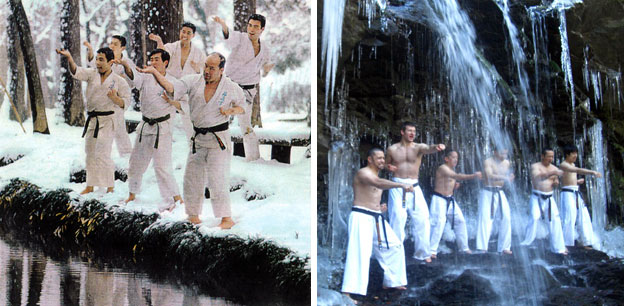
In his pursuit of perfection Oyama lived like a hermit in the mountains for years. He lived in relative isolation, free from distractions and tried to unite the body and mind through his rigorous training. His physical conditioning was brutal. Running, punching, kicking were the only things on his mind, that was when he was not trying to clear his mind through meditation. It wasn't as if he were punching a bag filled with sand either. He would punch and kick hard wood, or trees wrapped in rope and canvas. His skin became rough, his hands and feet calloused. The micro-fractures his limbs suffered by hitting hard surfaces had calcified, making his bones thicker and stronger. He could actually break rocks, stones and bottle necks with the edge of his hands. He trained day and night, in good weather as well as miserable weather. He worked out barefoot, even during the winter. He would run and train under icy waterfalls to harden his mind as well as his test his willpower. When he returned to challenge the community of martial artists he was able to drop most opponents with a single punch. The training regiment would be repeated by other karate practitioners. Many of his Kyokushin students joined Oyama on his journey as his legacy grew. Even after his death his die-hard students kept up with the practice. People would fly in from around the world with the hopes of becoming hardened like steel under the harsh conditions.
Older martial arts systems had their own training techniques which could be considered as brutal as anything that Oyama had suffered through. The Shaolin school, the ancestor of the kung-fu schools, had very strict guidelines. Practitioners ate a diet of vegetables and trained and mediated from morning until night. They too would harden their bones by punching hard wooden dummies, running up and down hills and even focus on strengthening tendons. The feats of superhuman strength and endurance shown by the masters of the fighting arts grew into legend. They truly seemed superhuman, even when compared to other fighters. Those that were strikers had gotten all of the glory. However there were men that had fought just as many opponents if not more than the fabled masters. There were men that had compiled 100, 200 or more undefeated battles in their lifetime. Because they settled the contests through the grappling arts rather than the striking arts they weren't as well remembered. It did not make them any less formidable though.
Wrestlers of the various forms applied themselves just as hard at their craft as the Japanese or Chinese fighters did. The conditioned themselves by running, sometimes with a teammate over their shoulder. They developed exercises to help them build strength in their joints, neck, back, shoulders and core. By swinging heavy weights and clubs they developed insane grip strength. They would perform rigorous calisthenics, sometimes thousands of repetitions per day to build stamina. Some of the grappling legends did not have the punches or kicks that made other fighters immortal there were still extremely dangerous. The best wrestlers could dislocate and break bones with ease. They knew how to cut, gouge, stretch and maim opponents without a weapon. Yet they also learned to temper their ability so as not to permanently disable an opponent. The same code of conduct almost chivalrous observed by other martial artists was also practiced by most world class grapplers.
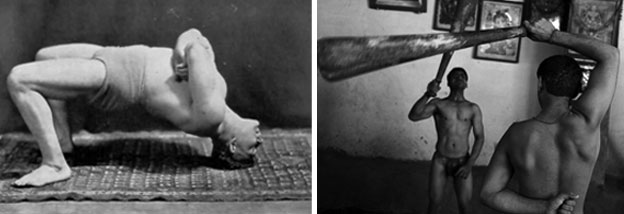
Players realized that the grapplers featured in fighting games were pulled from real world and pop culture influences. Some characters wore masks, others bizarre costumes, most wore traditional uniforms and let their abilities speak for themselves. The grappler was an appealing character because they were grounded in realism. They demonstrated that even mere mortals stood a chance against the martial arts heroes. In fighting games the grapplers did not have projectile moves. The lack of a "fireball" attack did not necessarily hold them back. The most extreme caricatures of a grappler made them iconic to gamers. Zangief, Darun Mister, Alex, Abel and Tendo Gai were just some of the wrestlers featured over the years in some fighting games.
Fans of wrestling history never forgot the influence of Catch on modern wrestlers and MMA fighters. Even comic book artists had been eager to put their spin on the wrestling legacy. The French writers and artists that worked on a series called Lucha Libre highlighted the various genres featured in wrestling matches and even movies. Masked wrestlers, monsters, mad scientists, damsels in distress, cool cars and even tikis had all been featured in one way of another. The most powerful fighter in the series was called King Catch. The masked warrior lived on a tropical island and would be a run in character featured with the Tikitis. The character was designed by Fabien M. Although he never crossed over into the Luchadores Five comics the people at Muttpop hired Monster5 to create a vinyl figure that would fit with the other heroes.
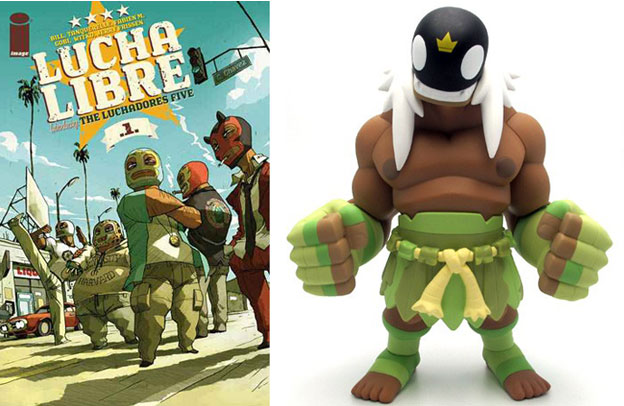
The Catch icons in MMA had shown the limitations of relying on one school of grappling for all the answers. They demonstrated that for every attack there was a defense, and for every hold there was a counter-hold. Fights were fluid and had to be approached as a series constantly changing situations. The people that froze up or relied too heavily on what they had been taught without adapting found themselves on the losing end of a battle. Lee, Oyama and the other fighting masters had come to this realization early on in their careers. The best fighters of the modern era learned that no one school held all the secrets to being a great fighter. The lessons in conditioning and strength training from various disciplines could help make a person physically capable of competing but the mental toughness required was something entirely different. The reason that Oyama and his students studied under harsh conditions was to help train their minds to deal with pain, fatigue or other forces that were beyond their control. The various schools of Karate, Kung-Fu, Judo, Wrestling and Ju-jitsu had taught the world that the striking arts were to be tempered with self-discipline. Knowing how to fight was never an excuse to fight.
Modern gladiators began to pick and choose the best elements from the traditional arts and began re-writing the book on training. They took the hard training from the Asian fighting arts. Building strong bones through repeated striking. Then the new generation of fighters then began developing core and grip strength workouts using classic tools like ropes and kettlebells but with cross training applications as well. The most important thing was the sharing of knowledge between martial arts schools. Students no longer had to limit their training to one system or another. If a fighter learned muay thai strikes from one teacher they were free to go to a different teacher and learn the nuances of boxing as well. Previously there was a stigma associated to "betraying" one school to learn from another. Now many instructors encourage diversity and experimentation. No one school was perfect for every build, body type, expertise or age. Exploration into the various systems meant that competing schools had to become more diversified. This would allow a person to cater to their strengths and build on their weaknesses. The end result were fighters that were well-rounded and would have made the early MMA pioneers proud.
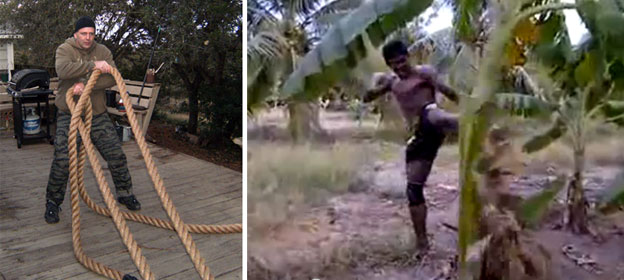
Despite the difficult cross training that the best fighters endured there always seemed to be the one fighter that was better than them. Maybe it was a classmate, a former friend or a bitter rival but there always seemed to be a superior fighter waiting in the wings. Perhaps the opponent got lucky or maybe they had indeed developed a better fighting system. Whatever the case was the loss often changed the path for a legend in the making. The next blog will look at the evolution of MMA in Eurasia as well as the myth of the elderly masters. As always if you enjoyed this blog and would like to sponsor me please visit my Patreon page and consider donating each month, even as little as $1 would help make better blogs and even podcasts!

No comments:
Post a Comment